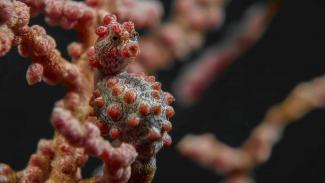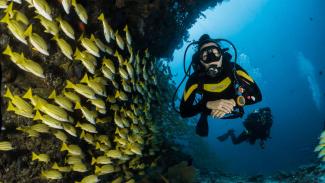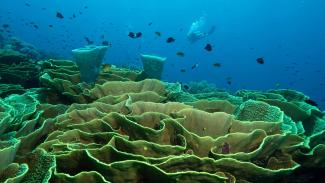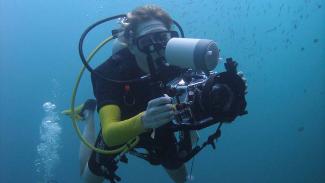Our guide to the magical muck diving in Lembeh Strait

Dorothea Oldani
Lembeh Strait separates little Lembeh island from the north-eastern shores of Sulawesi. It is famed for its exceptional muck diving.
The coastline either side of the Lembeh Strait has a rugged beauty, but it is the action below the waves that draws divers here.
This insignificant looking stretch of water is now widely considered to be the muck-diving capital of the world. All manner of weird and wonderful marine life is found in Lembeh and the diving sites are a mecca for both photographers and marine biologists.
Highlights
Best diving spots
Lembeh has around 35 diving sites, hiding all manner of strange species. Mimic Octopus, Wunderpus, Pygmy Seahorses, Flamboyant Cuttlefish, Giant Frogfish, Hairy Frogfish, Clown Frogfish, Giant Nudibranch’s, Stargazers and numerous Shrimps & Crabs all inhabit these black sandy slopes. Think of a strange underwater species, and chances are you will find it here.
Muck-diving sites are not usually beautiful in the traditional sense - colourful, healthy coral reefs are often conspicuous by their absence. But if you are a fan of all things weird and wonderful, or a photographer, they are absolutely fascinating. Hairball, Teluk Kembahu, Nudi Falls & Police Pier are just a few of the great muck-diving sites to visit.
If you fancy a change, the area has a few shipwrecks as well. Bimoli & Mawali are both large Japanese WWII wrecks that are now host to a wealth of marine life, while Kapal Indah, meaning beautiful ship, is a smaller wreck carpeted in lovely coral.
To the northern end of the strait, the visibility improves and there are some more traditional coral dive sites too, such as the beautiful Angel’s Window and California Dreamin'. Here, healthy populations of more common Indo-Pacific species can be found, in addition to many of the Lembeh Strait’s other stars. Also in the north, Batu Angus is a great dive to make at dusk to see mating Mandarinfish. Blue-ringed octopus can be seen here too.
Certain sites here can only be visited on certain tides as water can move fast through the strait. There is always somewhere interesting to dive in Lembeh though and those with a curious nature will find this area fascinating.
When to dive
The area can be dived all year round with different species prevalent at different times of year. The latter half of the year is probably the best time to dive Lembeh, although visibility can be lower than usual around August.
Getting there
Manado is the gateway to the Lembeh Strait, with flights from Singapore and Jakarta. From here, most resorts will provide a transfer to Lembeh. Depending on the location of the resort, a boat journey may also be required.
Lembeh makes a great combination with Bunaken, and also Bangka & Sangihe, all of which require a flight into Manado.
Activities
Diving is without doubt the main focus in Lembeh, with numerous excellent diving resorts. The resorts are well spread out and cater well for guests, so many visitors are unlikely to leave the resort except to go diving. Back on the mainland around Manado, there are many activities, ranging from shopping & golf to trekking.
Resort and liveaboard options
Lembeh is best dived from resort, with options to suit most budgets. Most resorts offer up to three boat dives per day in the Lembeh Strait, with excellent dive facilities, especially for underwater photographers. Occasionally, liveaboard itineraries begin in Lembeh and head south-east towards Raja Ampat via Halmahera.
You might also enjoy...
Ambon & the Banda Sea
The Banda Sea is a deep sea ringed by islands in eastern Indonesia. Right in the middle of the sea are the Banda Islands, while Ambon lies to the north.
While they may seem incredibly remote, they were once world famous as the Spice Islands, where nutmeg & mace - much sought after in those days - were grown & fought over by colonial powers.
Kimbe Bay
Kimbe Bay is on the island of New Britain, a large island running east to west that separates the Solomon Sea to the south from the Bismark Sea to the north.
The area is known for its stunning coral formations and boasts a huge diversity of marine life, from Dolphins, Sharks and Whales to endless tiny invertebrates.
Dummie's guide to camera kit
Jakob Owens
Do you struggle to know your arm from your socket, your port from your bracket, your flash from your fisheye and your light from your lens?
Well, you're not alone. Underwater photography has it's own dictionary of parts, accessories & technical terms and it's tough to sound like an expert.
Buyer's guide to underwater cameras
Tara North
If you are reading this article, then you probably have the bug. No doubt you’ve seen some incredible underwater photos in dive magazines or had a go and are eager for more.
There’s no doubt that having your own camera & housing is essential for your new hobby. There is such a wide range of options available today though, so how do you begin to choose?
Underwater photography hotspots
Asia is blessed with all the ingredients any budding underwater photographer could ever wish for.
It has an enormous variety of dive sites, incredible diversity, an almost limitless choice of subjects and many highly professional dive centres to choose from.
But where are some of the very best spots for underwater photography & video? Our quick guide gives you the lowdown...
Buyer's guide to underwater video
Tara North







